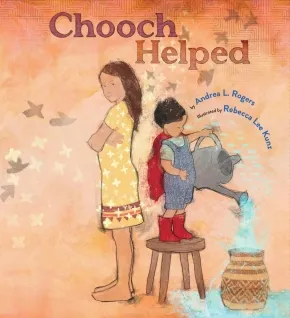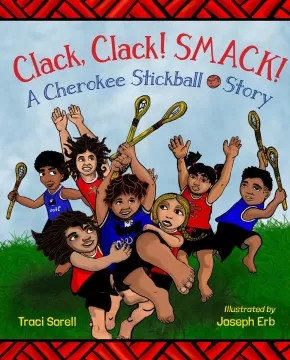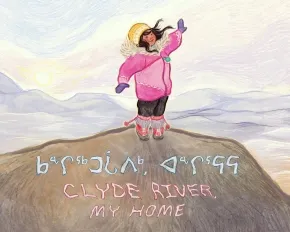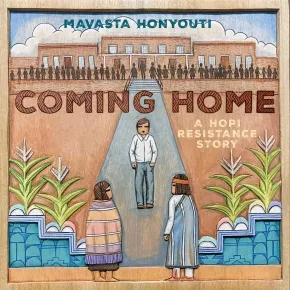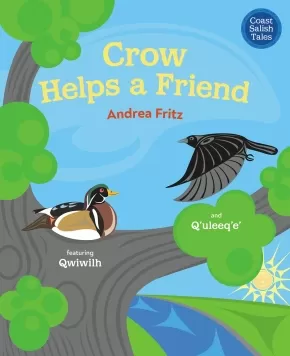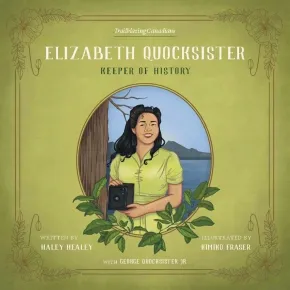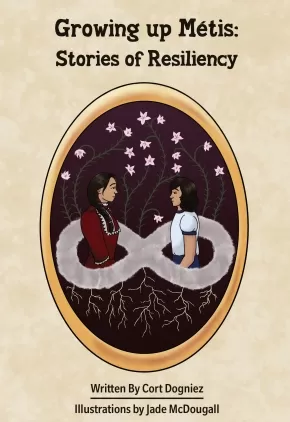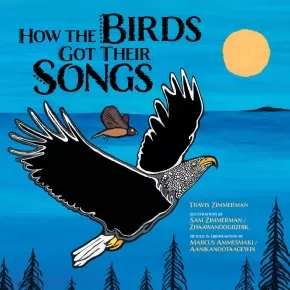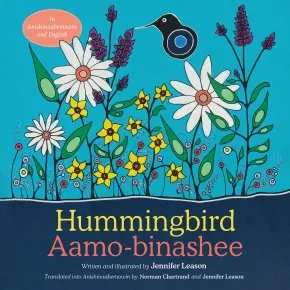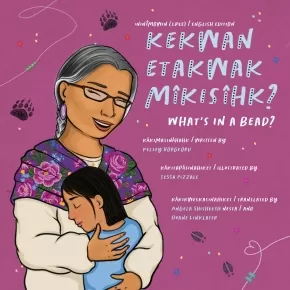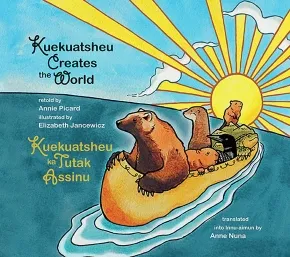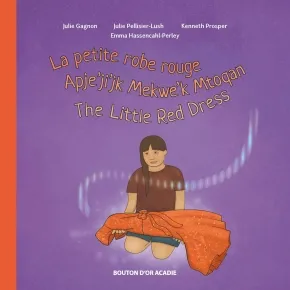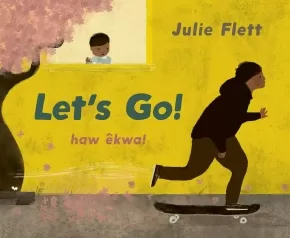
Indigenous Languages
46
-
60
of
295 Results;
Sort By
Go To
of 20
Resources in this category are written in an Indigenous language only (no English), in a dual- or triple-language format (at least one Indigenous language included alongside English), or with some words, phrases, or sentences from an Indigenous language included within the story to help with Indigenous language use and learning.
Chooch Helped
$29.99
Artists:
Format:
Hardcover
Text Content Territories:
Indigenous American; Native American; Cherokee;
ISBN / Barcode: 9781646144549
Synopsis:
Synopsis:
A Cherokee girl introduces her younger brother to their family's traditions — begrudgingly! — in this picture book written by Walter Award-winner Andrea L. Rogers and featuring gorgeous collage illustrations from debut artist Rebecca Lee Kunz.
Sissy’s younger brother, Chooch, isn’t a baby anymore. They just celebrated his second birthday, after all. But no matter what Chooch does — even if he’s messing something up! Which is basically all the time! — their parents say he’s just “helping.” Sissy feels that Chooch can get away with anything!
When Elisi paints a mural, Chooch helps. When Edutsi makes grape dumplings, Chooch helps. When Oginalii gigs for crawdads, Chooch helps. When Sissy tries to make a clay pot, Chooch helps . . .
“Hesdi!” Sissy yells. Quit it! And Chooch bursts into tears. What follows is a tender family moment that will resonate with anyone who has welcomed a new little one to the fold. Chooch Helped is a universal story of an older sibling learning to make space for a new child, told with grace by Andrea L. Rogers and stunning art from Rebecca Lee Kunz showing one Cherokee family practicing their cultural traditions.
Awards
- 2025 Randolph Caldecott Medal
Educator Information
Recommended for ages 4 to 8.
Additional Information
48 pages | 9.85" x 10.80" | Hardcover
Clack, Clack! Smack! A Cherokee Stickball Story
$21.99
Artists:
Format:
Hardcover
Text Content Territories:
Indigenous American; Native American; Cherokee; Cherokee Nation (Cherokee Nation of Oklahoma);
ISBN / Barcode: 9781623541934
Synopsis:
Synopsis:
Vann, a struggling stickball player, competes in a game on the Cherokee Nation. Can he help his team win? Written by award-winning Cherokee author Traci Sorell.
Vann loves playing his tribe’s stickball game, but he’s not as skilled as his teammates. Vann stumbles, and he tries and fails to score. How can he help his teammates win?
Exciting and fast-paced, Clack, Clack! Smack! reminds readers that sportsmanship and being a team player is just as important as being the star. Back matter explains the origins of Cherokee stickball.
Reviews
"Two Cherokee teams play a game of stickball in Tahlequah, Oklahoma. Vann feels insecure about having missed a key shot in last week’s match. “Stickball requires speed,” after all, and his “towering body” won’t cooperate. As Vann and his team, the Eagles, take to the field against the Redhawks, they “zip,” “chase,” and “rush” for the ball, their wooden sticks clashing with a “CLACK, CLACK!” Coach gives the team a pep talk in Tsalagi, the Cherokee language. He reminds them of gadugi, the importance of working together. As the players return to the field to finish the game, Vann’s best friend, Jesse, gives him an encouraging smile. The game is now tied. Can Vann and his team win? Sorell and Erb, both members of the Cherokee Nation, deliver an uplifting story of team spirit and collaboration; the emphasis is on group triumphs rather than individual victories. Writing in terse, alliterative prose—“a tackle, a twist, and a wrong turn”—Sorell skillfully builds tension as she choreographs this action-packed game. Erb’s thick-lined cartoon illustrations have a pleasing solidity; they capture the chaos and drama of the game and depict players with a range of brown skin tones. The story features frequent Tsalagi words and phrases. Backmatter stresses the importance of keeping the Cherokee language alive and explains the significance of stickball, which traditionally was used to settle conflicts. Stand and cheer for this fast-paced tale of sportsmanship and community." —Kirkus Reviews
Educator Information
Recommended for ages 4 to 7.
Additional Information
32 pages | 8.38" x 10.31" | Hardcover
Clyde River, My Home
$16.95
Artists:
Format:
Paperback
Grade Levels: Preschool; Kindergarten;
ISBN / Barcode: 9781774507711
Synopsis:
Synopsis:
Clyde River, Nunavut is a great place to live! In this bilingual picture book, Louise tells us about all the things she and her family like to do. With the annual fishing derby in the spring and Hamlet Day in the summer, there are lots of fun things to do throughout the year. Winter brings plenty of time to connect with people in the community and support each other. Learn about the different activities people do in each season in Clyde River, its landmarks, and the amazing wildlife you can see there, like bowhead whales.
Educator & Series Information
Recommended for ages 3 to 5.
Dual-Language: English & Inuktitut
This book is part of the Community Connections series.
Additional Information
27 pages | 8.00" x 10.00" | Paperback
Coming Home: A Hopi Resistance Story
$28.99
Artists:
Format:
Hardcover
ISBN / Barcode: 9781646144570
Synopsis:
Synopsis:
From master Hopi woodcarver Mavasta Honyouti, the story of his grandfather’s experience at a residential boarding school and how he returned home to pass their traditions down to future generations.
When Mavasta Honyouti was a boy he would go with his grandfather to their cornfield, watching him nurture every plant. During breaks, his grandfather would take out a piece of paako root and use his pocketknife to whittle away. He made beautiful carvings that Mavasta would later learn to do himself.
But Mavasta would often wonder: what was his kwa’a like when he was a boy? And one day, he heard the story.
Mavasta’s grandfather, like many Native American children across the country in the late 19th and early 20th century, was forced to leave his Hopi reservation as a child and go to a residential boarding school far away. There, the government cut his hair, punished him for speaking his native language, and gave him a new name. But Mavasta's grandfather never forgot who he was – or where he came from – and he tried to escape again and again. Finally, he made it back to their reservation.
In later years, Mavasta’s kwa’a chose a simple life, taking great care of his family just like he took great care of his plants. His son and later his grandson became acclaimed Hopi katsina woodcarvers, just like him. Coming Home: A Hopi Resistance Story is a deeply personal book – written in both English and Hopi – that features sixteen stunning original painted wood carvings. It is an unforgettable testament to one man rising above a painful piece of history to keep the light of his family and culture alive.
Educator Information
Recommended for ages 4 to 8.
Dual-language: English and Hopi.
Additional Information
48 pages | 9.00" x 9.20" | Hardcover
Crow Helps a Friend
$21.95
Artists:
Format:
Hardcover
Text Content Territories:
Indigenous Canadian; First Nations; Salish; Coast Salish; Lyackson ;
ISBN / Barcode: 9781459836242
Synopsis:
Synopsis:
Mistakes can be an opportunity for growth.
Indigenous artist and storyteller Andrea Fritz tells the tale of a wood duck and a crow who turn a mistake into an opportunity for friendship and growth.
Qwiwilh the wood duck is preparing to nest in his favorite tree when Q'uleeq'e' the crow invites him to play in the tall branches. They jump higher and higher up the tree until they accidentally break the branches and come crashing down into the stream below. After a daring rescue, Qwiwilh sadly realizes his nesting spot is gone, and Q'uleeq'e' decides to make things right for her new friend.
In this original story set in Coast Salish Traditional Territory, author and artist Andrea Fritz uses Indigenous storytelling techniques and art to share the culture and language of the Hul’q’umi’num’-speaking Peoples. This is the second book in the Coast Salish Tales, following Otter Doesn't Know.
Educator & Series Information
Recommended for ages 6 to 8.
This is the second book in the Coast Salish Tales series, following Otter Doesn't Know.
Recommended in the Indigenous Books for Schools catalogue as a valuable resource for English Language Arts and Art in K to Grade 3.
Themes: Animals, Art, Community, Connectedness to Nature, Respect, Language, Relationships, Traditional Knowledge
Additional Information
32 pages | 8.75" x 10.75" | Hardcover
Elizabeth Quocksister: Keeper of History (PB)
$12.95
Artists:
Format:
Paperback
Text Content Territories:
Indigenous Canadian; First Nations; Kwakwaka'wakw (Kwakiutl); Da'naxda'xw Awaetlala;
ISBN / Barcode: 9781772034851
Synopsis:
Synopsis:
The uplifting true story of Elizabeth Quocksister, a strong Indigenous woman and community leader, who dedicated her life to protecting her language and cultural traditions.
Elizabeth Quocksister (1925–81) had many roles in her life. She was a cultural teacher, a community leader, a dancer, a nurse, a photographer, a residential school survivor, and a mother of ten. Born on the Da’naxda’xw Nation on Knight Inlet on the central coast of British Columbia, Elizabeth spoke fluent Kwak’wala and proudly celebrated her Kwakwaka’wakw culture at a time when the Canadian government actively discouraged Indigenous traditions and the speaking of Indigenous languages. She cared for community members in need and saved many children from the horrors of residential school. She chronicled the daily lives, important events, and changing times of her community through photography—preserving her people’s history and culture for future generations. This inspiring picture book is a beautiful tribute to a proud Indigenous woman whose name deserves to be well-known throughout her community and beyond.
Educator Information
Recommended for ages 4 to 8.
Additional Information
32 pages | 9.00" x 9.00" | Paperback
Growing up Métis : Stories of Resiliency
$17.50
Artists:
Format:
Paperback
Text Content Territories:
Indigenous Canadian; Métis;
ISBN / Barcode: 978-1-988011-34-9
Synopsis:
Synopsis:
Cort Dogniez’s Growing up Métis: Stories of Resiliency is the second installment of his historical fiction series that began with Road to La Prairie Ronde. In two separate, but connected fictionalized stories, Cort delves into the lives of two of his foremothers: his great-grandmother, Josephine Gariepy and his grandmother, Clara Dumont when they were young. While highlighting the dispossession and marginalization of his ancestors following the 1885 Resistance, Cort deftly weaves Métis culture through these two stories with a positive “focus on nicknames, faith, storytelling, and a resilient spirit.”
Jade McDougall’s beautiful illustrations brings these poignant, coming of age stories to life. Growing up Métis: Stories of Resiliency includes Michif and Cree glossaries to reflect Josephine and Clara’s first languages as well as guide questions for educators to explore the stories and Métis culture in depth with their students.
Educator & Series Information
Recommended by the publisher for ages 9+.
This book is the second installment in the historical fiction series that began with Road to La Prairie Ronde.
Additional Information
85 Pages | 14 cm x 20.3 cm | Paperback
How the Birds Got Their Songs
$25.00
Format:
Hardcover
Text Content Territories:
Indigenous American; Native American; Anishinaabeg; Ojibwe (Chippewa); Grand Portage Band of Lake Superior Chippewa;
ISBN / Barcode: 9781681342856
Synopsis:
Synopsis:
The Great Spirit challenges all the birds to a contest, and the gift of birdsong is born! This traditional story, told in both English and Ojibwe, explains bird behavior and where humans should go to hear the prettiest of birdsongs.
When Mother Earth was very young and the Great Spirit had created all the beings, he noticed how quiet everything was. As he walked about the earth, listening to the sounds of the animals and the wind and the waters, some birds flying by caught his eye. He knew immediately what he needed to do.
The Great Spirit held a contest so that each bird could earn the song that was just right for its species. He called together all the birds, from the smallest sparrow to the largest hawk, and told them the plan. Each would fly as high in the sky as it could, and when it returned to Mother Earth it would receive its song.
Eagle was certain his strong wings would help him fly highest of all and earn the prettiest song. But he did not know that, while the Great Spirit was talking, the tiny hermit thrush had snuggled into eagle's feathers to take a nap.
All the birds flew and flew, higher and higher, each descending when it was time to return—and each receiving its own special song. But which bird flew the highest? Which one received the prettiest song?
This treasured story, handed down through author Travis Zimmerman's family, features traditional knowledge from the Grand Portage Band of Lake Superior Chippewa. Grand Portage descendant Sam Zimmerman's vibrant illustrations showcase his stylized artistry and deep appreciation for feathered creatures. Marcus Ammesmaki's retelling in Ojibwemowin brings the story full circle, encouraging language learners to explore this age-old depiction of our natural world—and inviting all readers to cherish the gift of birdsong.
Educator Information
Recommended for ages 3 to 7.
Dual-Language: English and Ojibwe.
Retold in Ojibwemowin by Marcus Ammesmaki / Aanikanootaagewin. Marcus is a K/1 teacher at Waadookodaading Ojibwe Language Institute in Hayward, Wisconsin.
Additional Information
32 pages | 10.00" x 10.00" | Hardcover
Hummingbird / Aamo-binashee
$21.95
Artists:
Format:
Hardcover
Text Content Territories:
Indigenous Canadian; First Nations; Anishinaabeg;
ISBN / Barcode: 9781459837140
Synopsis:
Synopsis:
You never walk alone.
Remember the hummingbird's teachings. Remember you are loved.
Kokum warned us to watch out for one another. If we weren't careful, Windigo would eat us. But one night, alone in the darkness, I felt its breath on my neck. Windigo's lies crept into my heart, and I believed them. When we lose connection with others, we lose ourselves, and Windigo's darkness grows and spreads.
In this deeply emotional and beautifully illustrated picture book, the ancestors send a hummingbird to a child lost in Windigo’s darkness. Its teachings of resilience, love and connection bring the child home and remind us that our ancestors are always watching and can help us find our way if we only ask.
This bilingual book includes full text in both English and Anishinaabemowin.
Educator Information
Recommended for ages 6 to 8.
Fountas & Pinnell Text Level Gradient: U
Lexile measure: 520L
Guided Reading Level: U
Dual-Language: English and Anishinaabemowin
There are many dialects fo Anishinaabemowin, and this book presents a phonetic spelling of the language as learned by the author and co-translator in Duck Bay, northeastern Manitoba. This dialect is sometimes referred to as Western Ojibwa, Nakawemowin, Saulteaux or Plains Ojibwa. Translated by Norman Chartrand and Jennifer Leason.
This beautifully illustrated story expresses hope, healing and reclamation of Indigenous strength and identity in the wake of oppression and trauma.
Additional Information
32 pages | 8.00" x 8.00" | Hardcover
It Bears Repeating
$23.99
Artists:
Format:
Hardcover
Text Content Territories:
Indigenous Canadian; Inuit;
ISBN / Barcode: 9781774880555
Synopsis:
Synopsis:
This beautifully crafted picture book celebrates one of the world's most awesome animals: the polar bear. Evocative but simple text by award-winning musician and artist Tanya Tagaq is accompanied by striking art in this classic counting book.
Beginning with 1 proud polar bear standing tall and ending with 10 bears waving goodbye, this delightful counting book shows polar bears in all their forms: slippery and fast, crafty and cool, hungry and proud. Tanya has created a story meant to be read aloud, incorporating simple Inuktitut words and using her keen ear for the musical sound of language.
This book is joyful, powerful, clever and striking — much like the bears who sniff, slide, swim, hunt, play and dance through its pages. And when you get to the last page, you won't be able to resist going back to repeat the journey!
Educator Information
Recommended for ages 3 to 7.
Concepts: Counting & Numbers; Animals - Polar Bears.
This book is meant to be read aloud and incorporates simple Inuktitut words.
Additional Information
24 pages | 10.50" x 9.00"
It Is Good to Live in Beautiful Arctic Bay
$16.95
Artists:
Format:
Paperback
Text Content Territories:
Indigenous Canadian; Inuit;
Grade Levels: Preschool; Kindergarten;
ISBN / Barcode: 9781774507933
Synopsis:
Synopsis:
Lucy loves living in Arctic Bay. There are so many things to do in each season! In the winter during "the great darkness," Lucy likes watching the northern lights. She is always excited to welcome the sun back in the spring. In the summer, Lucy can't wait to go blueberry picking, camping, and eat pissi. Follow along with Lucy as she takes readers through the seasons and shares all her favourite things about living in beautiful Arctic Bay.
Educator & Series Information
Recommended for ages 3 to 5.
Dual-Language: English and Inuktitut.
This book is part of the Community Connections series.
Additional Information
29 pages | 9.00" x 8.00" | Paperback
kekwan etakwak mîkisîhk / What’s in a Bead?
$21.95
Artists:
Format:
Hardcover
Text Content Territories:
Indigenous Canadian; First Nations; Anishinaabeg; Cree (Nehiyawak);
ISBN / Barcode: 9781772603675
Synopsis:
Synopsis:
There are many stories in a bead. We must listen to the stories they tell us.
Tessa loves how her grandmother always smells of campfire stories. Mom says it’s because Kohkom spends her days sewing beautiful beads onto smoked hides. Inspired, Tessa asks Kohkom to teach her beading, but first she must listen and learn about the many stories held in a bead.
A celebration of Cree craftsmanship, language, and learning. The loving exchange of knowledge between Tessa and her Kohkom will be familiar to many children. Readers will learn that different Indigenous communities have different beadwork techniques, and that this traditional art form is alive and thriving today.
Reviews
"The story is a beautiful look into the importance of beading in our communities and the ways that this art practice ties us together as families and communities." — Nancy Cooper, First Nations Consultant for the Southern Ontario Library Services and coordinator for First Nation Communities Read
Educator Information
Recommended for ages 6 to 8.
This dual language edition contains the story in both Ininîmowin (Cree, N-dialect) and English.
Translators: Duane Linklater & Angela Shisheesh
Duane is Omaskêko Ininiwak and currently lives in North Bay, Ontario. He earned a Master of Fine Arts from Bard College and a Bachelor of Native Studies with a focus in Cree language from the University of Alberta. Linklater is lifelong learner of the Cree language and credits the many Elders, including his kohkom Agnes Hunter, for teaching and sharing the language.
Angela is a Cree translator at Ojibway & Cree Cultural Centre based in Timmins, Ontario
An English-only version is available: What's in a Bead?
This book is available in French: Le pouvoir d'une perle
Additional Information
24 pages | 8.50" x 8.50" | Hardcover
Kuekuatsheu Creates the World / Kuekuatsheu ka Tutak Assinu: (Sheshatshiu dialect)
$24.99
Artists:
Format:
Hardcover
ISBN / Barcode: 9781998802203
Synopsis:
Synopsis:
The story of how the world came to be on the turtle's back can be found in Indigenous cultures throughout North America/Turtle Island. It has many variations. This moving version of the tale—a story of resilience, sacrifice, and friendship—is one that Annie Picard was often told as a child by her maternal grandmother while they lived in nutshimit (on the land) in the Labrador/Quebec peninsula. Picard's lovely re-telling of this traditional Innu story of how little muskrat makes an enormous sacrifice to help the wolverine and his other friends rebuild the world after a great flood is brought vividly to life by Elizabeth Jancewicz's stunning illustrations.
Educator Information
Recommended for ages 4 to 8.
Bilingual: English and Innu-aimun.
Translation into Innu-aimun by Anne Nuna.
Additional Information
36 Pages | 9" x 8" | Hardcover | 2nd Edition
La petite robe rouge / Apje'ji'jk Mekwe'k Mtoqan / The Little Red Dress
$15.95
Format:
Paperback
Text Content Territories:
Indigenous Canadian; First Nations; Mi'kmaq;
ISBN / Barcode: 9782897503482
Synopsis:
Synopsis:
Sakari loves to rummage through her grandmother's house, but she doesn't know what's hidden in the woven basket her nukumi keeps in the attic. Then, one day, she sees her nukumi in tears by the open basket, holding a photo album with poems and photos that Sakari has never seen. This prompts the older woman to tell her the story of her younger sister who disappeared shortly after graduating high school. Sakari will help her nukumi to free herself from this heavy secret and allow the spirit of the missing young woman to fly away in peace.
This trilingual book, in English, French, and Mi'kmaq, is an excellent introduction to Red Dress Day, which aims to raise awareness for Missing and Murdered Indigenous Women and Girls.
Educator Information
The publisher recommends this book as an all-ages picture book.
Trilingual: French, Mi'kmaq, and English
Additional Information
32 pages | 8.50" x 8.50" | Paperback
Let's Go! haw êkwa
$23.95
Artists:
Format:
Hardcover
Text Content Territories:
Indigenous Canadian; First Nations; Cree (Nehiyawak);
ISBN / Barcode: 9781771646109
Synopsis:
Synopsis:
An extraordinary book that celebrates skateboarding, family, and community, from beloved artist and author Julie Flett, a winner of the New York Times / New York Public Library Best Illustrated Children’s Book Award.
Every day, a little boy watches kids pass by on skateboards, and dreams of joining them. One day, his mother brings a surprise: her old skateboard, just for him! haw êkwa! Let’s go! Together, they practice on the sidewalk, at the park, in Auntie’s yard—everywhere. But when it comes time to try the skatepark, the skateboarders crash down like a waterfall. Can he find the confidence to join them?
Let’s Go! features:
- A glossary of Cree words featured in the book, and a Cree refrain (haw êkwa!) repeated throughout
- A note to the reader from Julie Flett about her inspiration for the story
This fun and touching story is a tribute to family, friendship, and perseverance. Julie Flett’s renowned art and powerful text shows a community of support is all around, ready to help each other… go!
Reviews
“Beautifully highlights the value of perseverance along with the joy of skateboarding.”—Horn Book, STARRED Review
“Extraordinary…. A fun read from start to finish, "Let's Go!" is especially and unreservedly recommended as a choice pick for family, daycare center, preschool, elementary school, and community library Self-Esteem and Family Life picture book collections for ages 3-8.”—Midwest Book Review
“Masterful, simple, powerful….a must-read for anyone who skateboards or wants to — or doesn’t.”—Amina Chaudri, Booklist
“Using onomatopoeic language to capture the sounds of the sport, Cree-Métis creator Flett (We All Play) shows the hard work and investment of time that goes into both learning a new skill and becoming ‘a part of something—/ and myself.’”—Publishers Weekly, STARRED review
Educator Information
Recommended for ages 3 to 8.
Curriculum Connections: Sports / Indigenous Languages / Community / Goal-Setting / Risk-Taking / Self-Awareness / Self-Confidence
This book is available in French: On y va!
Recommended in the Indigenous Books for Schools catalogue as a valuable resource for English Language Arts, Art, and Physical and Health Education in kindergarten to grade 3.
Additional Information
44 pages | 11.00" x 9.00" | Hardcover
Sort By
Go To
of 20

